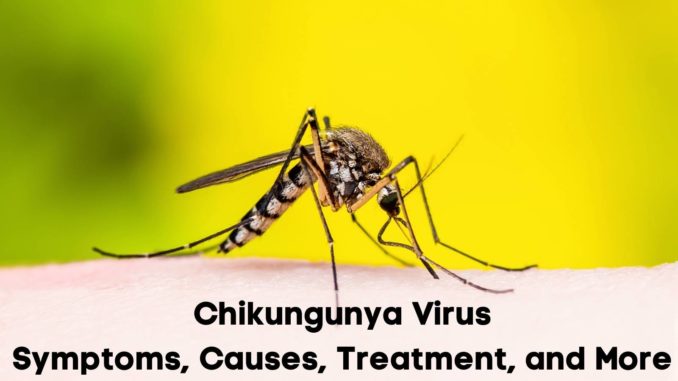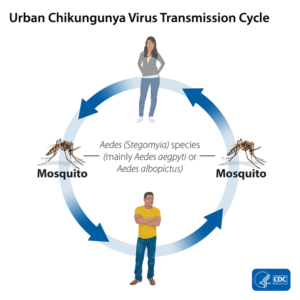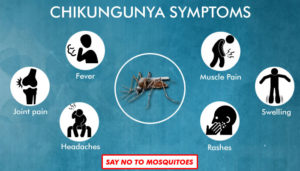
Table of Contents
What is Chikungunya?
- Chikungunya fever is a disease that results from a virus transmitted through mosquito bites.
- Chikungunya is caused by the chikungunya virus and is characterized by a sudden onset of fever and joint pain, which can be excruciating and incapacitating.
- The virus that leads to chikungunya is a type of RNA virus that belongs to the Toga viridae family.
- The name ‘chikungunya’ means “that which bends up” or “stooped walk” due to the virus causing extreme muscle and joint pain.
Key Facts
- After being discovered in approximately 40 locations across Asia, Africa, Europe, and most recently the Americas, chikungunya was first identified during an outbreak in southern Tanzania in 1952.
- There were more than 2 million cases of chikungunya reported between 2004 and 2013, with the majority of those cases occurring in the Indian Ocean region.
- The first locally transmitted chikungunya cases were discovered in the Americas in 2013, and since then, outbreaks have been reported in a number of nations, including Brazil, Colombia, and Mexico.
- The signs and symptoms of the disease often appear 4 to 8 days following a mosquito bite, though they can potentially appear up to 12 days later.
Causes of Chikungunya
- Chikungunya fever is a disease that results from infection with the chikungunya virus.
- The primary mode of transmission of this virus is through the bites of infected mosquitoes, with the Aedes aegypti and Aedes albopictus species being the most significant vectors.
Mode of Transmission
- The Chikungunya virus is typically transmitted to humans via the bite of an infected mosquito, primarily Aedes aegypti and Aedes albopictus.
- The virus can also be transferred by blood transfusion, organ transplantation, and during childbirth from a mother to her newborn.
- There have been a few examples of human-to-human transmission from infected blood or other body fluids.

Symptoms of Chikungunya
- Symptoms typically starts 4-8 days (2-12 days range) after a mosquito bite, causing an abrupt onset of fever and severe joint pain that can last for days, weeks, or even years.
- Other common symptoms include joint swelling, muscle pain, headache, nausea, fatigue, and rash, which can lead to misdiagnosis with other infections such as dengue and Zika viruses.
- Mild symptoms may occur in some infected individuals.
- Although most patients recover completely, some may develop complications such as eye, heart, and neurological issues
- The complications are more common in newborns and older adults with underlying medical conditions, and may even result in death.
- Recovered individuals are likely to be immune from future infections.

Risk Factors
- Living in or traveling to areas where the virus is present
- Failure to use a bed net while sleeping during the day
- Keeping open containers of water that can serve as breeding sites for Aedes mosquitoes, which can lay their eggs in standing water
- Lack of immunity to the virus
- Newborns and older adults at higher risk of developing severe disease and complications
- The immune system can be weakened by pre-existing medical conditions, making an individual more susceptible to infection
- Pregnancy, with potential risks to the fetus
- Receiving a blood transfusion or organ transplant from an infected donor can also lead to infection with the virus.
- Direct contact with infected blood or other body fluids (rare cases of human-to-human transmission).
- Living with people having chikungunya signs and symptoms
High Risk Groups
- Neonates
- Individuals who are 65 years old or older
- Those who have pre-existing medical conditions like hypertension, diabetes, or heart disease
Diagnosis of Chikungunya
- Using techniques such as reverse transcriptase-polymerase chain reaction (RT-PCR), the Chikungunya virus can be diagnosed directly in blood samples collected during the first week of disease.
Complications
- Chronic joint pain
- Neurological disorders like encephalitis, meningitis, and Guillain-Barré syndrome.
- Eye infections such as conjunctivitis or uveitis, which may lead to vision problems or even blindness.
- Cardiovascular disorders like myocarditis or pericarditis.
- Increased risk of death in certain populations, such as older adults and those with underlying medical conditions.
Prevention
- There is no vaccination available to protect against chikungunya virus infection.
- The most effective strategy to avoid chikungunya is to avoid mosquito bites.
- Wear long-sleeved shirts and pants, treat clothing and gear, and conduct mosquito control measures both indoors and outside.
Treatment
- There is no specific antiviral treatment for this disease; nevertheless, a number of alternative therapies are being investigated.
- Rest, drinks, and analgesics and antipyretics may be used to treat symptoms.
- Nonsteroidal anti-inflammatory medications (NSAIDs) can be used to treat fever and pain.
- Nonsteroidal anti-inflammatory medications, corticosteroids, especially topical formulations, and physical therapy might help people with chronic joint pain.
WHO Response
The WHO takes various actions in response to chikungunya, which include:
- Assisting countries in detecting outbreaks by utilizing their network of laboratories.
- Offering technical support and guidance to countries to manage the outbreak of mosquito-borne diseases.
- Developing new tools, such as insecticide products and application technologies, and evaluating their effectiveness.
- Creating strategies, policies, and management plans based on scientific evidence to manage outbreaks.
- Providing technical support and guidance to countries for the effective management of cases and outbreaks.
- Improving reporting systems of countries by providing support.
- Offering training at the regional level, in collaboration with centers, on clinical management, diagnosis, and vector control.
- Publishing guidelines and handbooks on epidemiological surveillance, laboratory, clinical case management, and vector control for Member States.
- Promoting integrated multidisciplinary approaches to arboviral diseases through the implementation of the Global Arbovirus Initiative.
References and For More Information
https://www.ncbi.nlm.nih.gov/pmc/articles/PMC5998769/
https://www.hindawi.com/journals/av/2021/8847906/
https://www.cdc.gov/chikungunya/geo/index.html
https://www.who.int/news-room/fact-sheets/detail/chikungunya
https://www.paho.org/en/topics/chikungunya
https://www.ecdc.europa.eu/en/chikungunya/facts/factsheet
https://www.ncbi.nlm.nih.gov/books/NBK534224/
https://www.webmd.com/a-to-z-guides/what-is-chikungunya
https://apps.who.int/iris/bitstream/handle/10665/205166/B4289.pdf
https://www.nature.com/articles/nrrheum.2017.223